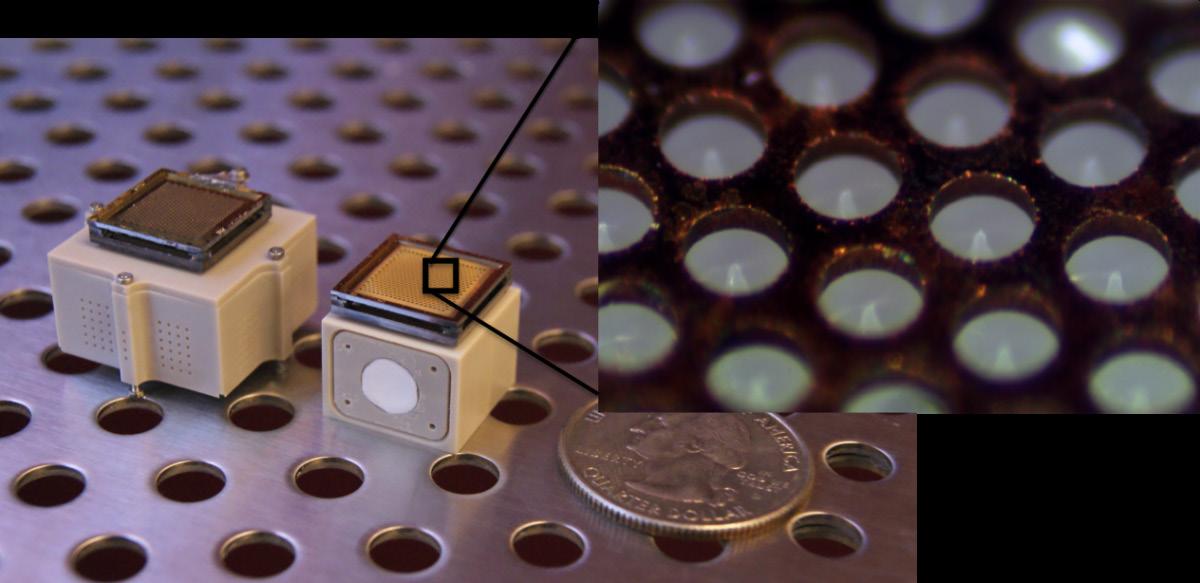
3 minute read
Electrowetting Valve Manufacturing and Testing for Electrospray Thruster Production
Nigel Barnett1, Matthew Corrado2, Paulo Lozano3
1 Student Contributor, Department of Aeronautics and Astronautics, MIT, Cambridge MA 02139
Advertisement
2 Supervisor, Department of Aerospace Engineering, MIT, Cambridge MA 02139
3 Principal Investigator, Department of Aerospace Engineering, MIT, Cambridge MA 02139
Nanosatellites are cheap to produce and launch; however, a lack of control after being released into orbit means nanosatellites typically have shorter lifespans than their larger counterparts. The MIT Space Propulsion Laboratory (SPL) has been developing modular electrospray thrusters that satisfy this need for small- scale satellite propulsion. Electrospray thrusters (Fig. 1) are compact engines that incorporate micro- electromechanical systems (MEMS) to combine electric charge and charged fuel to create thrust. Such thrusters could provide control to operators on the ground, allowing them to maneuver satellites away from debris, for electrospray thruster propellant control. These electrowetting valves initially separate an electrospray thruster's fuel tank and emitter (nozzle) until it needs to be fired. At that point, the thruster systems apply a charge across the valve, changing its hydrophobicity, allowing the fuel to reach the emitter and create thrust.
For the duration of a launch, thruster components can face more than 12 Gs of acceleration, intense vibration, and thermal cycling before reaching the ideal conditions of orbital microgravity (Krejci, 2016). Those forces can cause thruster valves to fail and allow fuel to reach the emitters prematurely, leading to malfunctions and reduced performance. These extreme conditions that the raise satellite orbits to correct for atmospheric drag in low Earth orbit, and perform more complex missions.

The small scale and high efficiency of electrospray propulsion mean that mission planners can add modular thrusters to extend the mission life of a satellite (Greene, 2008). However, while electrospray propulsion has many benefits, the small size of an electrospray thruster presents challenges for manufacturing. Components like emitter arrays and fuel valves must be manufactured precisely, requiring complex microfabrication processes similar to computer chips. This research project focuses on how the SPL can reliably produce electrically actuated valves thruster experiences and the micro-scale of fabrication make it challenging to manufacture reliable valves.
This project focuses on refining and standardizing the process for manufacturing the electrowetting valves. Each silicon valve substrate is spin coated in a special hydrophobic fluoropolymer. This fluoropolymer, called Fluoropel, is an electrowetting agent that allows the valve to change its interaction with fluids when an electrical field is applied (Kim et al., 2010). We can measure this interaction between the valve and fuel by the contact angle of a drop of fluid. Before the thruster needs to be fired, a large contact angle and high hydrophobicity are optimal so that fuel does not seep through the microscopic valve channels leading to the emit- ter. But when thrust is required, an electrical field can be applied to reduce the contact angle of the valve (Fig. 2) and allow fuel to pass through the valve and power the thruster.
So far, the project has been focused on initial tests of the impact of curing procedures on the contact angle between water and a valve test piece, as shown in figure two. The table below highlights the current results from contact angle testing. Chip set 1 tested the difference in curing times: 30 minutes at 180°C versus 20 minutes at 80°C and then 30 minutes at 180°C. Because of the non-uniformity in the surface finish of the 30-minute valve (Fig. 3), chip set 2 was coated at the same conditions, 3000 rotations per minute (RPM) for five seconds, and cured for the same time as chip set 1. Chip set 2 had a uniform surface finish, so chip set 3 was coated under different spin coating conditions, 5000 RPM for 30 seconds, to test if any trends in contact angle between curing times persisted to the most extreme spin coating conditions.

Given the collected data in Table 1, the current conclusion is that the vendor-recommended curing setting of 30 minutes at 180°C is optimal, even at a more extreme coating of 5000 RPM. However, there is some uncertainty in the significance of the different curing procedures, given that two drops on the same chip could produce up to 12° of difference in measured contact angle.
The next step for the project is to follow a test matrix to characterize the contact angle based on spin coating parameters and find the optimal spin coating settings for the largest contact angle. The test matrix varies two independent components of the fluoropolymer coating procedure: spin duration and RPM. Therefore, a trend in contact angle should be observed by changing these parameters, and the combination with the largest contact angle will be chosen for future electrowetting valve manufacturing.
After determining a suitable procedure for coating the valves, they will be environmentally tested to determine their performance at launch and determine if they are more reliable than previous versions. If they can withstand environmental testing consistently, the project focus will shift to producing more valves for SPL for future thruster production. However, if the valves are unreliable, more work will go into varying the curing settings and spin coating procedure to find a coating procedure that produces a robust valve.
References

Greene, Courtney. 2008. Application of an Electrospray Thruster in a Nanosatellite. Department of Mechanical Engineering. Retrieved on 22 March 2023 from https://dspace.mit.edu/ bitstream/handle/1721.1/45839/319618231-MIT.pdf.
Kim, JH., Lee, JH., Mirzaei, A. et al. 2020. Electrowetting-on-dielectric characteristics of ZnO nanorods Nature. Retrieved on 22 March 2023 from https://doi.org/10.1038/s41598-020-71017-7.
Krejci, David. 2016. Electrospray Thruster Engineering. Retrieved on 22 March 2023 from https://spacepropulsion.mit. edu/electrospraythruster-engineering. thruster experiences and the micro-scale of fabrication make it challenging to manufacture reliable valves.







